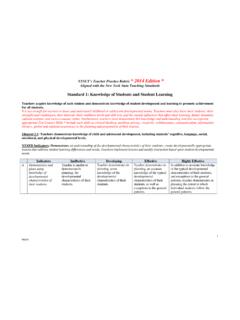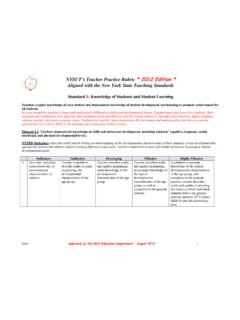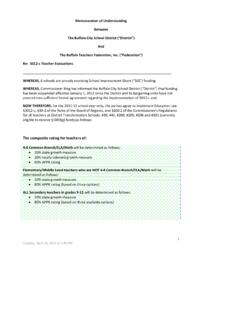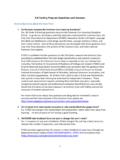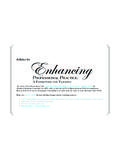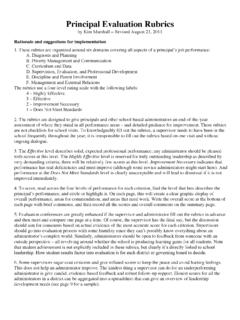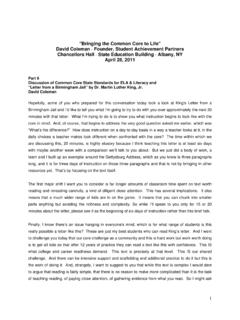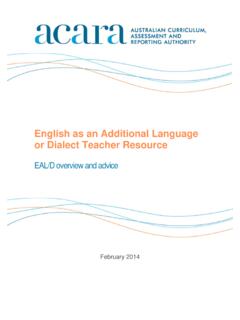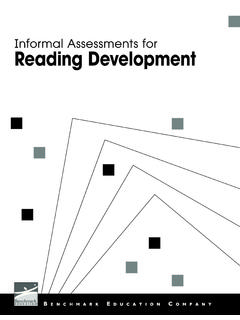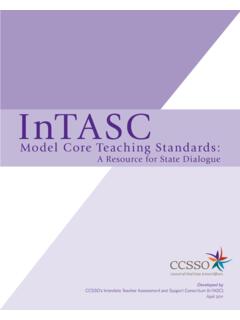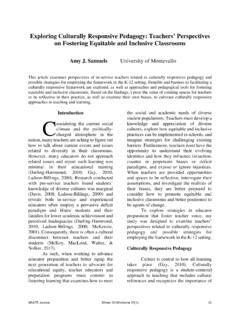Transcription of Multidimensional Principal Performance Rubric
1 Multidimensional Principal Performance Rubric 2011 Learner-Centered Initiatives, Ltd and Communities for Learning: Leading lasting change 1 Domain 1 Shared Vision of Learning An education leader promotes the success of every student by facilitating the development, articulation, implementation, and stewardship of a vision of learning that is shared and supported by all stakeholders. 1 In the electronic version, Culture is hyperlinked to an input PowerPoint. 2 In the electronic version, shared vision is hyperlinked to an annotated shared visioning activity. Ineffective 1 Developing 2 Effective 3 Highly Effective 4 Culture1 (attitudes, knowledge, behaviors and beliefs that characterize the school environment and are shared by its stakeholders)
2 Claims to have a vision and mission for the school, but keeps it private identifies the school s vision and mission, and makes them public collaborates with key stakeholders in the school to develop and implement a shared vision and mission for learning engages stakeholders representing all roles and perspectives in the school in the development, monitoring and refinement of a shared vision2 and mission for learning school vision and mission are unrelated to the district vision and mission school vision and mission are created in isolation of the district s vision and mission and aligned as an afterthought school vision and mission aligns with the vision and mission of the district school vision and mission intentionally align with the vision and mission of the district and contribute to the improvement of learning district wide disregards the need to use the school s vision and mission to guide goals, plans and actions refers to the school vision and mission as a document unconnected to programs, policies or practices explicitly links the school s vision and mission to programs and policies uses the school s vision and mission as a compass to inform reflective practice, goal-setting.
3 And decision-making Sustainability (a focus on continuance and meaning beyond the present moment, contextualizing today s successes and improvements as the legacy of the future) assumes that the school s improvement is either an event or the responsibility of a single individual provides selected staff with opportunities to discuss school improvement efforts has a process and structure in place for organizational improvement and uses it to assess the school uses and regularly evaluates strategic processes and structures to promote the school s continuous and sustainable improvement Multidimensional Principal Performance Rubric 2011 Learner-Centered Initiatives, Ltd and Communities for Learning: Leading lasting change 2 Domain 2 School Culture and Instructional Program An education leader promotes the success of every student by advocating, nurturing, and sustaining a school culture and instructional program conducive to student learning and staff professional growth.
4 Ineffective 1 Developing 2 Effective 3 Highly Effective 4 Culture (attitudes, knowledge, behaviors and beliefs that characterize the school environment and are shared by its stakeholders) acknowledges the need for communication and collaboration considers proposals for collaborative structures and projects supports various teaming opportunities, common planning and inquiry time, and visitations within the organization to increase learning and improve practice establishes different ways of accessing staff expertise and work by promoting activities such as lab sites, peer coaching, mentoring, collegial inquiry, etc. as an embedded part of practice provides selected individuals with basic information about various collaborative teaching, learning and work-related concepts or practices to several individuals encourages selected staff to expand their understanding of particular practices that support collaboration such as collaborative planning, co-facilitation or integrated curriculum design develops a culture of collaboration, trust, learning, and high expectations by encouraging staff to work together on key projects ( , induction processes, program design, integrated curriculum, or other individual or organizational projects)
5 Nurtures and sustains a culture of collaboration, trust, learning, and high expectations by providing structured opportunities for cross role groups to design and implement innovative approaches to improving learning, work and practice creates a learning environment that relies on teacher -controlled classroom activities, rote learning, student compliance and learning opportunities that are disconnected from students experiences, needs or cultures creates a learning environment in which students are passive recipients in learning opportunities that are only peripherally connected to their experiences or cultures creates a personalized and motivating learning environment for students in which they are involved in meaningful and relevant learning opportunities that they recognize as connected to their experiences, needs and cultures engages stakeholders ( , students , staff, parents) in developing and sustaining a learning environment that actively involves students in meaningful,3 relevant learning that is clearly connected to their experiences, culture and futures, and require them to construct meaning of concepts or processes in deductive or inductive ways 3 In the electronic version, meaningful will hyperlink to an activity on engagement and meaningfulness Multidimensional Principal Performance Rubric 2011 Learner-Centered Initiatives, Ltd and Communities for Learning: Leading lasting change 3 Domain 2 (cont.)
6 Ineffective 1 Developing 2 Effective 3 Highly Effective 4 Instructional Program (design and delivery of high quality curriculum that produces clear evidence of learning) promotes a curricular program that provides students with limited, surface or cursory exposure to a topic, concept or skill set and establishes or defines meaning for students , focusing on the recall of isolated concepts, skills and/or facts establishes a curricular program focused primarily on recall, comprehension and factual knowledge acquisition that enables students to develop a basic understanding of a topic and/or process and includes few, if any, opportunities for them to construct meaning creates a comprehensive, rigorous, and coherent curricular program that address all levels of thinking, enables students to develop knowledge and skills related to a concept, problem, or issue.
7 And supports their construction of meaning during the most important lessons and tasks engages students and teachers in designing and revising a learner-centered curricular program that integrates basic and higher levels of thinking throughout and provides opportunities for students to emulate professionals and construct meaning as they engage in a thorough exploration of a concept, problem, issue, or question maintains a hands off approach to instruction provides mixed messages related to expectations for instructional methodology and own understanding of best practices supervises instruction and makes explicit the expectation that teachers remain current in research-based, best practices and incorporate them into their own work supervises instruction on an ongoing basis, and engages in collegial opportunities for learning, action research and/or inquiry related to best practices in teaching and learning initiates actions that interrupt instructional time and distract from learning ( , meetings, announcements, unplanned assemblies, phone calls to teachers in classrooms, etc.)
8 Allows actions that disrupt instructional time and distract from learning ( meetings, announcements, unplanned assemblies, phone calls to teachers in classrooms, etc.) maximizes time spent on quality instruction by protecting it from interruptions and inefficient scheduling, minimizing disruption to instructional time involves diverse stakeholders in uncovering issues that challenge time spent on quality instruction and in innovative approaches to dealing with them Multidimensional Principal Performance Rubric 2011 Learner-Centered Initiatives, Ltd and Communities for Learning: Leading lasting change 4 Domain 2 (cont.) Ineffective 1 Developing 2 Effective 3 Highly Effective 4 Capacity Building (developing potential and tapping existing internal expertise to promote learning and improve practice) assumes titled leaders are able to handle administrative responsibilities and teachers to be able to instruct students invests in activities that promote the development of a select group of leaders develops the instructional and leadership capacity of staff develops and taps the instructional and leadership capacity of all stakeholders in the school organization to assume a variety of formal and informal leadership roles in the school is unaware of effective and appropriate technologies available provides the necessary hardware and software.
9 And establishes the expectation that teachers will integrate technology into student learning experiences promotes the use of the most effective and appropriate technologies to support teaching and learning and ensures that necessary resources are available engages varied perspectives in determining how to best integrate the use of the most effective and appropriate technologies into teaching, learning and the daily workings of the school organization Sustainability4 (a focus on continuance and meaning beyond the present moment, contextualizing today s successes and improvements as the legacy of the future) uses accountability to justify a system that links student achievement with accolades and blame assessment and accountability systems, though in place, are misaligned so that it is difficult to see how data from one explicitly relates to or informs the other develops assessment and accountability systems to monitor student progress, uncover patterns and trends, and provide a way to contextualize current student strengths and needs inside a history that connects changes in teaching and learning to student achievement.
10 Facilitates regular use of easily accessible assessment and accountability systems that enable students , teachers, and parents to monitor student progress, teacher learning, uncover patterns and trends, and provides a way to contextualize student achievement, both inside history and projected into the future. 4 In the electronic version, Sustainability will hyperlink to a PowerPoint providing input on Sustainability. Multidimensional Principal Performance Rubric 2011 Learner-Centered Initiatives, Ltd and Communities for Learning: Leading lasting change 5 Domain 2 (cont.) Ineffective 1 Developing 2 Effective 3 Highly Effective 4 Strategic Planning Process: monitoring/inquiry (the implementation and stewardship of goals, decisions and actions) judges the merit of the instructional program based on what is used by others evaluates the impact of the instructional program based on results of standardized assessments gathers input from staff and surveys students as well as formal assessment data as part of process to monitor and evaluate the impact of the instructional program provides time and the expectation for students and staff to participate in multiple cycles of field testing, feedback and revision of the instructional program in order to monitor and evaluate its impact and make necessary refinements to support continuous improvement Multidimensional Principal Performance Rubric 2011 Learner-Centered Initiatives, Ltd and Communities for Learning.
